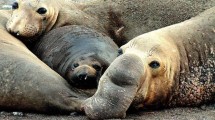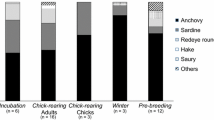Abstract
In diving seabirds, sexual dimorphism in size often results in sex-related differences of foraging patterns. Previous research on Magellanic penguins, conducted during the breeding season, failed to reveal consistent differences between the sexes on foraging behavior, despite sexual dimorphism. In this paper, we tested the hypothesis that male and female Magellanic penguins differ in diet and foraging patterns during the non-breeding period when the constraints imposed by chick rearing activities vanish. We used stable isotope ratios of carbon and nitrogen in feather and bone to characterize the diet and foraging patterns of male and female penguins in the South Atlantic at the beginning of the 2009–2010 and 2010–2011 post-breeding seasons (feathers) and over several consecutive breeding and migratory seasons (bone). The mean δ13C and δ15N values of feathers showed no differences between the sexes in any of the three regions considered or in the diet composition between the sexes from identical breeding regions; however, Bayesian ellipses showed a higher isotopic niche width in males at the beginning of the post-breeding season. Stable isotope ratios in bone revealed the enrichment of males with δ13C compared with females across the three regions considered. Furthermore, the Bayesian ellipses were larger for males and encompassed those of females in two of the three regions analyzed. These results suggest a differential use of winter resources between the sexes, with males typically showing a larger diversity of foraging/migratory strategies. The results also show that dietary differences between male and female Magellanic penguins may occur once the constraints imposed by chick rearing activities cease at the beginning of the post-breeding season.






Similar content being viewed by others
References
Adams NJ, Brown CR (1990) Energetics of molt in penguins. In: Davis LS, Darby JT (eds) Penguin biology. Academic Press, San Diego, pp 297–315
Bearhop S, Waldron S, Votier SC, Furness RW (2002) Factors that influence assimilation rates and fractionation of nitrogen and carbon stable isotopes in avian blood and feathers. Physiol Biochem Zool 75(5):451–458
Bearhop S, Phillips RA, McGill R, Cherel Y, Dawson DA, Croxall JP (2006) Stable isotopes indicate sex-specific and long-term individual foraging specialization in diving seabirds. Mar Ecol Prog Ser 311:157–164
Bertellotti M, Tella J, Godoy J, Blanco G, Forero M, Donázar J, Ceballos O (2002) Determining sex of Magellanic penguins using molecular procedures and discriminant functions. Waterbirds 25:479–484
Bligh E, Dyer W (1959) A rapid method of total lipid extraction and purification. Can J Biochem Physiol 37:911–917
Boersma PD, Rebstock GA (2009) Foraging distance affects reproductive success in Magellanic penguins. Mar Ecol Prog Ser 375:263–275
Boersma PD, Rebstock G, Frere E, Moore SE (2009) Following the fish: penguins and productivity in the South Atlantic. Ecol Monogr 79(1):59–76
Bugoni L, McGill RA, Furness RW (2010) The importance of pelagic longline fishery discards for a seabird community determined through stable isotope analysis. J Exp Mar Biol Ecol 391:190–200
Bunn SE, Loneragan NR, Kempster MA (1995) Effects of acid washing on stable isotope ratios of C and N in penaeid shrimp and seagrass: implications for food-web studies using multiple stable isotopes. Limnol Oceanogr 40:622–625
Cherel Y, Hobson KA, Weimerskirch H (2000) Using stable-isotope analysis of feathers to distinguish moulting and breeding origins of seabirds. Oecologia 122:155–162
Cherel Y, Pütz K, Hobson KA (2002) Summer diet of king penguins (Aptenodytes patagonicus) at the Falkland Islands, southern Atlantic Ocean. Polar Biol 25(12):898–906
Cherel Y, Hobson KA, Bailleul F, Groscolas R (2005) Nutrition, physiology, and stable isotopes: new information from fasting and molting penguins. Ecology 86(11):2881–2888
Clarke J, Manly B, Kerry K, Gardner H, Franchi E, Corsolini S, Focardi S (1998) Sex differences in Adélie penguin foraging strategies. Polar Biol 20:248–258
DeNiro MJ, Epstein S (1977) Mechanism of carbon isotope fractionation associated with lipid synthesis. Science 197:261–263
Drago M, Cardona L, Crespo EA, Aguilar A (2009a) Ontogenic dietary changes in South American sea lions. J Zool 279:251–261
Drago M, Crespo EA, Aguilar A, Cardona L, García N, Dans SL, Goodall N (2009b) Historic diet change of the South American sea lion in Patagonia as revealed by isotopic analysis. Mar Ecol Prog Ser 384:273–286
Fonseca VS, Petry MV, Jost AH (2001) Diet of the Magellanic penguin on the coast of Rio Grande do Sul, Brasil. Waterbirds 24:290–293
Forero MG, Tella JL, Donázar JA, Blanco G, Bertellotti M, Ceballos O (2001) Phenotypic assortative mating and within-pair sexual dimorphism and its influence on breeding success and offspring quality in Magellanic penguins. Can J Zool 79:1414–1422
Forero MG, Hobson KA, Bortolotti GR, Donázar JA, Bertellotti M, Blanco G (2002) Food resource utilisation by the Magellanic penguin evaluated through stable-isotope analysis: segregation by sex and age and influence on offspring quality. Mar Ecol Prog Ser 234:289–299
Frere E, Gandini PA, Lichtschein V (1996) Variación latitudinal en la dieta del Pingüino de Magallanes (Spheniscus magellanicus) en la costa Patagónica, Argentina. Ornitol Neotrop 7:35–41
Gandini PA, Frere E, Holik TM (1992) Implicancias de las diferencias en el tamaño corporal entre colonias para el uso de medidas morfométricas como método de sexado en Spheniscus magellanicus. Hornero 13:211–213
González-Solís J, Smyrli M, Militão T, Gremillet D, Tveraa T, Phillips RA, Boulinier T (2011) Combining stable isotope analyses and geolocation to reveal kittiwake migration. Mar Ecol Prog Ser 435:251–261
Hobson KA, Clark RG (1992a) Assessing avian diets using stable isotopes I: turnover of 13 C in tissues. Condor 94:181–188
Hobson KA, Clark RG (1992b) Assessing avian diets using stable isotopes II: factors influencing diet-tissue fractionation. Condor 94:189–197
Jackson AL, Inger R, Parnell AC, Bearhop S (2011) Comparing isotopic niche widths among and within communities: SIBER–Stable Isotope Bayesian Ellipses in R. J Anim Ecol 80(3):595–602
Lorrain A, Savoye N, Chauvaud L, Paulet Y, Naulet N (2003) Decarbonation and preservation method for the analysis of organic C and N contents and stable isotope ratios of low-carbonated suspended particulate material. Anal Chim Acta 491:125–133
Mäder A, Sander M, Casa Jr G (2010) Pinguins-de-magalhães arribados na costa do Rio Grande do Sul: composição da dieta e ecologia alimentar. III Congresso Brasileiro de Oceanografia Rio Grande
Mizutani H, Fukuda M, Kabaya Y (1992) 13C and 15N enrichment factors of feathers of 11 species of adult birds. Ecology 73:1391–1395
Newsome SD, Etnier MA, Aurioles-Gamboa D, Koch PL (2006) Using carbon and nitrogen isotope values to investigate maternal strategies in northeast Pacific otariids. Mar Mammal Sci 22:556–572
Ogawa N, Ogura N (1997) Dynamics of particulate organic matter in the Tamagawa Estuary and inner Tokyo Bay. Estuar Coast Shelf Sci 44:263–273
Parnell A, Inger R, Bearhop S, Jackson AL (2008) SIAR: stable isotope analysis in R. http://cran.r-project.org/web/packages/siar/index.html
Pinnegar JK, Polunin NVC (1999) Differential fractionation of δ13C and δ15N among fish tissues: implications for the study of trophic interactions. Funct Ecol 13:225–231
Pinto MBLC, Siciliano S, Di beneditto PM (2007) Stomach contents of the Magellanic penguin Spheniscus magellanicus from the northern distribution limit on the Atlantic coast of Brazil. Mar Ornithol 35:77–78
Pütz K, Ingham RJ, Smith G (2000) Satellite tracking of the winter migration of Magellanic penguins Spheniscus magellanicus breeding in the Falkland Islands. Ibis 142:614–622
Pütz K, Ingham RJ, Smith JG (2002) Foraging movements of Magellanic penguins Spheniscus magellanicus during the breeding season in the Falkland Islands. Aquatic Conserv Mar Freshw Ecosyst 12:75–87
Pütz K, Schiavini A, Raya Rey A, Lüth BH (2007) Winter migration of magellanic penguins (Spheniscus magellanicus) from the southernmost distributional range. Mar Biol 152:1227–1235
Quillfeldt P, McGill R, Furness RW (2005) Diet and foraging areas of Southern Ocean seabirds and their prey inferred from stable isotopes: review and case study of Wilson’s storm-petrel. Mar Ecol Prog Ser 295:295–304. doi:10.3354/meps295295
Raya Rey A, Pütz K, Scioscia G, Lüthi B, Schiavini A (2012) Sexual differences in the foraging behaviour of Magellanic Penguins related to stage of breeding. Emu 112:90–96
Sala JE, Wilson RP, Frere E, Quintana F (2012) Foraging effort in Magellanic penguins in coastal Patagonia, Argentina. Mar Ecol Prog Ser 464:273–287
Schiavini A, Yorio P, Gandini P, Raya Rey A, Boersma PD (2005) Los Pingüinos de las costas Argentinas: estado poblacional y conservación. Hornero 20:5–23
Schreer JF, Kovacs KM (1997) Allometry of diving capacity in air-breathing vertebrates. Can J Zool 75:339–358
Scolaro J (1978) El Pingüino de Magallanes (Spheniscus magellanicus) IV. Notas biológicas y de comportamiento. Serie Científica. Publicaciones ocasionales del Instituto de Biología Animal. Serie científica 10:1–6
Scolaro J (1984) Revisión sobre la biología de la reproducción del pingüino de Magallanes (Spheniscus magellanicus) El ciclo biológico anual. Contribución Centro Nacional Patagónico 91:1–26
Stokes DL, Boersma PD (1999) Where breeding Magellanic penguins Spheniscus magellanicus forage: satellite telemetry results and their implications for penguin conservation. Mar Ornithol 27:59–65
Stokes DL, Boersma PD, Davis LD (1998) Satellite tracking of Magellanic penguins migration. Condor 100:376–381
Syväranta J, Lensu A, Marjomäki TJ, Oksanen S, Jones RI (2013) An empirical evaluation of the utility of convex hull and standard ellipse areas for assessing population niche widths from stable isotope data. PLoS One 8(2):e56094. doi:10.1371/journal.pone.0056094
Tieszen LL, Boutton TW, Tesdahl KG, Slade NA (1983) Fractionation and turnover of stable carbon isotope in animal tissue: implications for δ13C analysis of diet. Oecologia 57:32–37
Walker B, Boersma P (2003) Diving behavior of Magellanic penguins (Spheniscus magellanicus) at Punta Tombo, Argentina. Can J Zool 81:1471–1483. doi:10.1139/z03-142
Watanuki Y, Burger AE (1999) Body mass and dive duration in alcids and penguins. Can J Zool 77:1838–1842
Williams TD (1995) The penguins. Oxford University Press, Oxford
Wilson RP (2003) Penguins predict their performance. Mar Ecol Prog Ser 249:305–310
Wilson RP, Scolaro JA, Peters G, Laurenti S, Kierspel M, Gallelli M, Upton J (1995) Foraging areas of Magellanic penguins Spheniscus magellanicus breeding at San Lorenzo, Argentina, during the incubation period. Mar Ecol Prog Ser 1299:1–6
Wilson RP, Scolaro JA, Grémillet D, Kierspel MAM, Laurenti S, Upton J, Gallelli H, Quintana F, Frere E, Müller G, Straten MT, Zimmer I (2005) How do Magellanic penguins cope with variability in their access to prey? Ecol Monogr 75:379–401
Acknowledgments
This research was funded by Fundación BBVA through the project “Efectos de la explotación humana sobre depredadores apicales y la estructura de la red trófica del Mar Argentino durante los últimos 6.000 años” (BIOCON 08-194/09 2009-2011) and Agencia Nacional de Promoción Científica y Tecnológica (PICT No. 2110). At the time, this manuscript was written, L. S. and D.V. were supported by a Doctoral Fellowship Program from the Consejo Nacional de Investigaciones Científicas y Técnicas de la República Argentina (CONICET), and F.S. was supported by a Fellowship from Ministerio de Ciencia e Innovación (Spain). We also thank the respective Conservation Agencies from the provinces of Rio Negro, Chubut, Santa Cruz and Rio Grande do Sul for the permits to work and collect samples in their protected areas, and the Centro Nacional Patagónico (CENPAT-CONICET) for institutional and logistical support. Finally, L.S. wants to thanks especially to the public and free education system of Argentina.
Author information
Authors and Affiliations
Corresponding author
Additional information
Communicated by S. Garthe.
Rights and permissions
About this article
Cite this article
Silva, L., Saporit, F., Vales, D. et al. Differences in diet composition and foraging patterns between sexes of the Magellanic penguin (Spheniscus magellanicus) during the non-breeding period as revealed by δ13C and δ15N values in feathers and bone. Mar Biol 161, 1195–1206 (2014). https://doi.org/10.1007/s00227-014-2410-1
Received:
Accepted:
Published:
Issue Date:
DOI: https://doi.org/10.1007/s00227-014-2410-1




